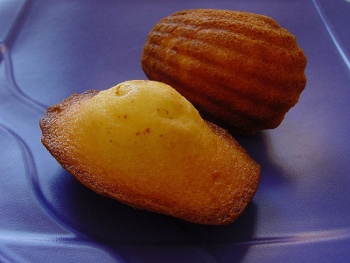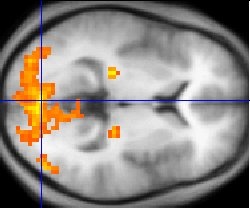Smell
October 23, 2013
Since humans are
chemical reactors,
Nature has fitted us with
chemoreceptors to allow us to sort the good
chemicals from the bad in our
feedstock. These are our
senses of
smell (more properly,
olfaction) and
taste, which are two of the five traditional senses of man, the others being
sight,
hearing and
touch
We humans are loathe to admit our
animal nature, but
pheromones affect our mate choice. Since we're humans, we try to use our
intelligence to advantage, so we work to
game the system. The global
perfume and
fragrance market is about thirty billion dollars.
Electronic technology has produced a number of
electronic noses for detection of odors. These work by detecting the
electrical charge or
mass of
adsorbed odorant
molecules on
metal–oxide–semiconductor field-effect transistors,
conducting polymers,
quartz crystal microbalances, or
surface acoustic wave devices.
Smell and taste can trigger
memories, an often used example of this effect appearing in
Marcel Proust's "
À la recherche du temps perdu," commonly translated as "Remembrance of Things Past." In this
novel, there's a scene known as the "episode of the
madeleine" in which the taste of a
cake triggers a childhood memory. Most men will admit that the scent of a certain perfume will bring back memories of a
girlfriend.

Some rather nice looking madeleine cakes, temptation enough for me to deviate from my oatmeal breakfast regimen.
(Photo by Bernard Leprêtre, via Wikimedia Commons.)
Psychologists at the
University of Wisconsin (Madison, Wisconsin) uncovered a variant of the Proust effect by demonstrating that unpleasant things can transform a benign smell into a bad smell.[1-2] As they report in a recent issue of the
Journal of Neuroscience, human subjects exposed to disturbing pictures and text about
automobile accidents and
wartime violence will subsequently perceive an associated neutral odor as distasteful.[2] The
brain effectively rewires itself under a stressful circumstance to reinforces negative feelings.[2]
The lead author of the study is
Wen Li, a
professor of psychology at the University of Wisconsin-Madison
Waisman Center.[1] Says Li,
"After anxiety induction, neutral smells become clearly negative... People experiencing an increase in anxiety show a decrease in the perceived pleasantness of odors. It becomes more negative as anxiety increases."[2]
To discern what was happening to the brain, itself, Li's team used
functional magnetic resonance imaging (fMRI) on a dozen human subjects as they processed neutral odors in an anxious state. Li's team found that the separate brain areas known to process smell and
emotion became intertwined under conditions of anxiety, the brain working from a unified
network of these systems. It appears that the emotional state becomes part of olfactory processing when a person becomes anxious.[2]

Functional magnetic resonance image, not from the University of Wisconsin study, showing brain areas involved with processing moving images.
(Via Wikimedia Commons.)
One interesting chapter in the
history of smell is the ever-ridiculed
Smell-O-Vision,
patented by Hans Laube in 1959.[3] This system, which produced odors
synchronized to scenes in a
film, was credited by
Time magazine in
2000 as one of the "Top 100 Worst Ideas of All Time".[4]
The song,
Smells Like Teen Spirit, by the
American alternative rock band,
Nirvana references the smell of
Teen Spirit deodorant. When band leader,
Kurt Cobain, titled the song, he had no knowledge of the deodorant product. The title was supposed to be an
allusion to the detection of an emotional state.
How can any article about smell resist in displaying an image of the world's most famous
nose, that of
French playwright,
Cyrano de Bergerac (1619-1655). It's said that people would travel long distances just to view his overly large nose.

Cyrano de Bergerac
Cyrano is famous, not just for his nose, but as the author of "The Comical History of the States and Empires of the Moon (L'Autre monde ou les états et empires de la Lune)," one of the first science fiction stories.
It starts, "After many experiments I constructed a flying machine, and, sitting on top of it, I boldly launched myself in the air..."[5]
(Via Wikimedia Commons.)
References:
- Elizabeth A. Krusemark and Wen Li, "From Early Sensory Specialization to Later Perceptual Generalization: Dynamic Temporal Progression in Perceiving Individual Threats," The Journal of Neuroscience, vol. 33, no. 2 (January 9, 2013), pp. 587-594.
- Terry Devitt, "A shot of anxiety and the world stinks," University of Wisconsin Press Release, September 24, 2013.
- Hans Laube, "Motion pictures with synchronized odor emission," US Patent No. 2,905,049, Sep 22, 1959.
- Jim Drobnick, Ed., "The Smell Culture Reader," (Berg Publishers, 2006, ISBN 1-84520-213-9), p. 360, as referenced in Wikipedia.
- Sir John Alexander Hammerton and Arthur Mee, Eds., "The World's Greatest Books — Volume 01 — Fiction," from Project Gutenberg.
Permanent Link to this article
Linked Keywords: Metabolism; chemical reactor; Nature; chemoreceptor; chemical compound; chemical; raw material; feedstock; sense; smell; olfaction; taste; sight; hearing; touch; animal; pheromone; body odor; mate choice; intelligence; gaming the system; perfume; fragrance oil; market; electronic technology; electronic nose; electric charge; electrical charge; mass; adsorption; adsorbed; molecule; MOSFET; metal–oxide–semiconductor field-effect transistor; conducting polymer; quartz crystal microbalance; surface acoustic wave device; long-term memory; Marcel Proust; In Search of Lost Time; À la recherche du temps perdu; novel; madeleine; cake; girlfriend; oatmeal; breakfast; Wikimedia Commons; psychologist; University of Wisconsin (Madison, Wisconsin); Journal of Neuroscience; traffic collision; automobile accident; wartime; brain; Wen Li; professor; Waisman Center; functional magnetic resonance imaging; emotion; network; history; Smell-O-Vision; patent; synchronization; synchronized; film; Time magazine; 2000; Smells Like Teen Spirit; American; alternative rock; Nirvana; Teen Spirit deodorant; Kurt Cobain; allusion; nose; French; playwright; Cyrano de Bergerac (1619-1655); The Comical History of the States and Empires of the Moon; science fiction.